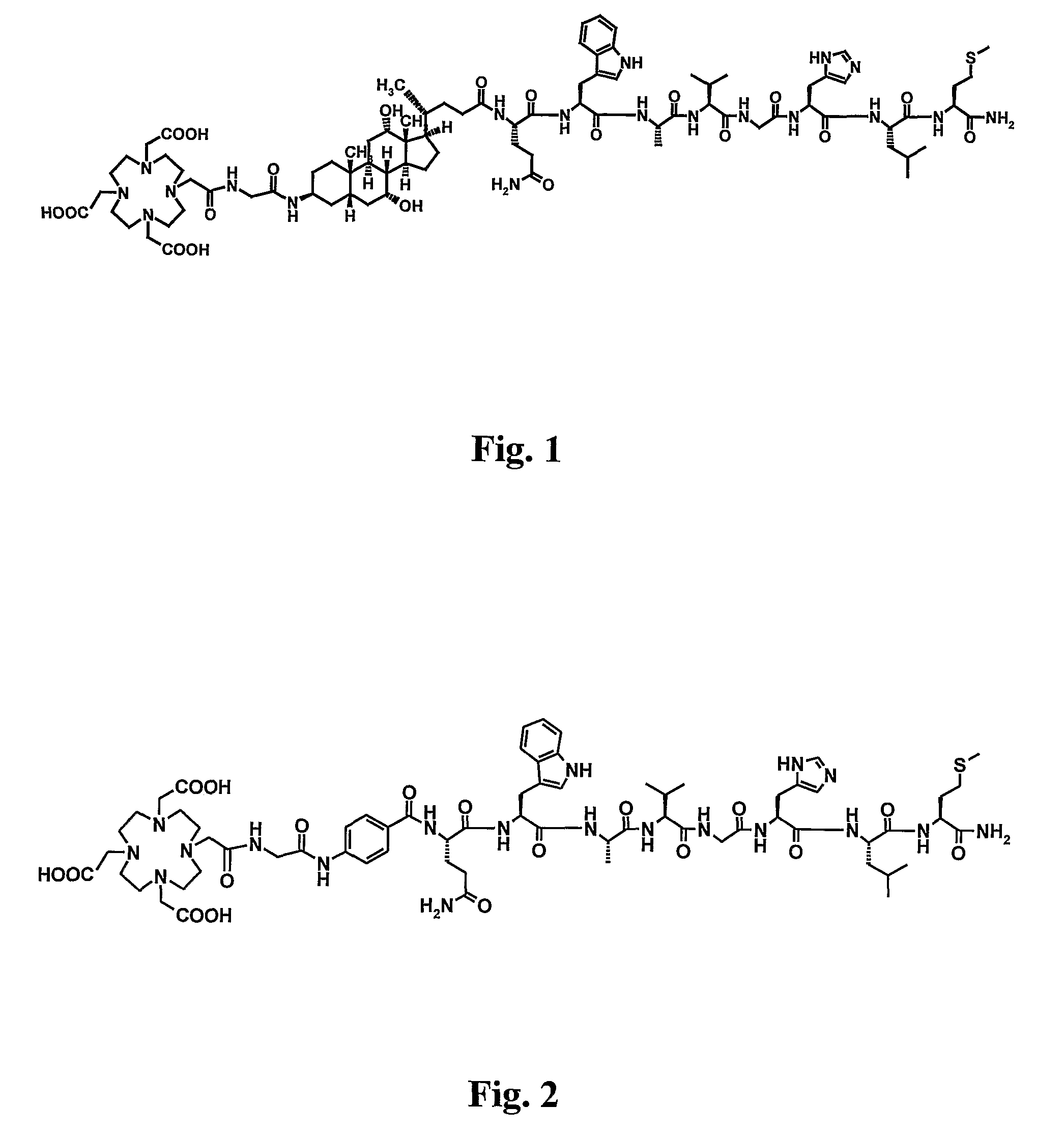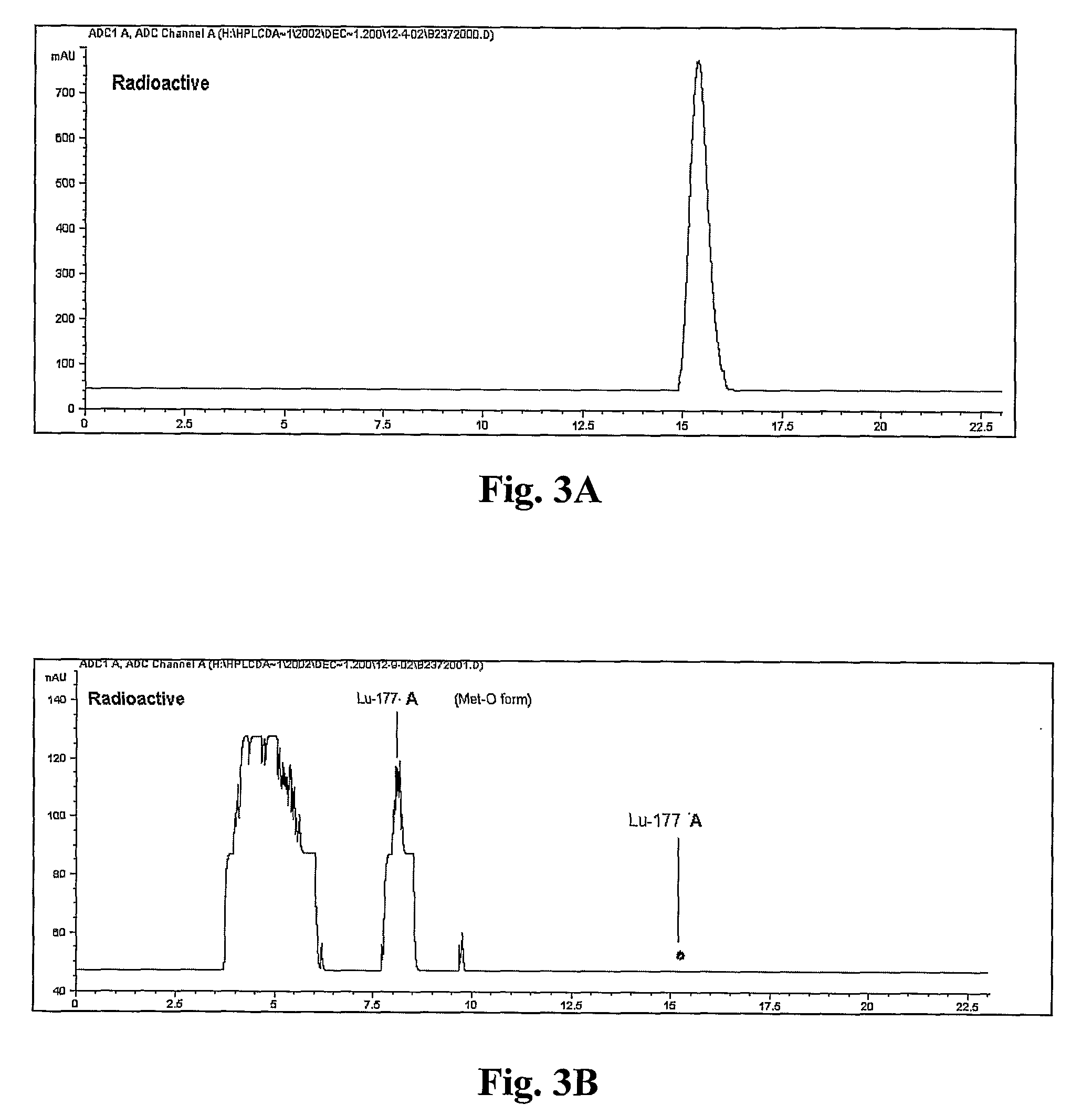Stable Radiopharmaceutical Compositions and Methods for Preparation
a radiopharmaceutical composition and stable technology, applied in the field of stabilizers, can solve the problems of hydroxyl radical [oh*], hydroxyl radical [oh*], and the water in tissues to form free radicals, so as to improve the radiolytic stability of targeted radiopharmaceuticals, restore oxidative damage, and high efficacy
- Summary
- Abstract
- Description
- Claims
- Application Information
AI Technical Summary
Benefits of technology
Problems solved by technology
Method used
Image
Examples
example 1
Comparison of the Radioprotective Effects of Various Amino Acids When Added to Pre-Formed 177Lu-GRP Binding Compounds 177Lu-A or 177Lu-B
[0243] EXAMPLE 1 shows the results obtained for a series of amino acids that were added individually to a solution of 177Lu-A or 177Lu-B and then incubated at room temperature over 48 hours, as well as results for an unstabilized control. In these reactions, the amino acid concentration was 6.6 mg / mL, 177Lu-A and 177Lu-B had a concentration of ˜20 mCi / mL, and 3.5 mCi of 177Lu was used in each reaction.
[0244] Solutions of the individual amino acids L-Methionine, L-Selenomethionine, L-cysteine HCl.H2O, L-Tryptophan, L-Histidine, and Glycine were prepared at a concentration of 10 mg / mL in 10 mM Dulbecco's phosphate-buffered saline, pH 7.0 [PBS].
[0245]177Lu-A and 177Lu-B were prepared by adding 300 μL of 0.2 M NaOAc (pH 5.0), 40 μg Compound A or B and 20 mCi of 177LuCl3 into a reaction vial. The mixture was incubated at 100° C. for five minutes, then...
example 2
Further Evaluation of the Radioprotective Effect of L-Methionine for Radioprotection of 177Lu-A (50 mCi / 2mL)
[0248] Based on the results seen in EXAMPLE 1, the ability of L-methionine to protect 177Lu-A when added after complex formation was studied. In contrast to EXAMPLE 1 above, in this reaction, 50 mCi of 177Lu-A was used, rather than 3.5 mCi.
[0249]177Lu-A was formed by adding ˜70 μg of Compound A and 50 mCi of 177LuCl3 (molar ratio of peptide to Lutetium of 3:1) to 1 mL of 0.2M NaOAc, pH 5.0. The mixture was heated at 100° C. for 5 min, cooled to room temperature in a water bath, and 1 mL of a 5 mg / mL L-methionine solution in water and 1 mg Na2EDTA.2H2O was added into the reaction vial. The chromatograms in FIG. 8 and the data in Table 4 below demonstrate the changes in radiochemical purity observed over 5 days at room temperature, when analyzed by reversed phase HPLC using HPLC Method 3. Table 4 summarizes the results shown in FIG. 8.
TABLE 4177Lu-A (50 mCi in 2 mL) stabiliz...
example 3
Evaluation of the Radioprotective Effect of Various Reagents When Added to Pre-Formed 177Lu-A (3.5 mCi)
[0252] The list of the potential radiolysis protecting agents tested in this experiment is as follows:
[0253] 1. Ascorbic acid (Sodium salt form)
[0254] 2. Gentisic acid (Sodium salt form)
[0255] 3. Human Serum Albumin (HSA)
[0256] 4. 3,4-pyridinedicarboxylic acid (Sodium salt) (PDCA)
[0257] 5. 10% Ethanol aqueous solution
[0258] 6. 2% Hypophosphorous acid (HPA)
[0259] 7. 2% Mercaptoethanol (ME)
[0260] 8. Tris(carboxyethyl)phosphine (TCEP)
[0261] 9. Control (Phosphosaline buffer, pH 7.0)
[0262] Reagents 1-5 have been reported previously to be potentially useful as stabilizers for radiopharmaceuticals. Reagents 6-8 are compounds that were tested to determine their ability to serve as reducing agents for any methionine sulfoxide residues that formed as a result of radiolysis. Reagent 9 was used in the unstabilized control.
[0263]177Lu-A was prepared by adding 300 μL of 0.2 M NaOAc (...
PUM
| Property | Measurement | Unit |
|---|---|---|
| cell diameters | aaaaa | aaaaa |
| concentration | aaaaa | aaaaa |
| single photon energy | aaaaa | aaaaa |
Abstract
Description
Claims
Application Information
 Login to View More
Login to View More - R&D
- Intellectual Property
- Life Sciences
- Materials
- Tech Scout
- Unparalleled Data Quality
- Higher Quality Content
- 60% Fewer Hallucinations
Browse by: Latest US Patents, China's latest patents, Technical Efficacy Thesaurus, Application Domain, Technology Topic, Popular Technical Reports.
© 2025 PatSnap. All rights reserved.Legal|Privacy policy|Modern Slavery Act Transparency Statement|Sitemap|About US| Contact US: help@patsnap.com



